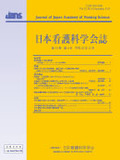Japanese
English
- 販売していません
- Abstract 文献概要
- 参考文献 Reference
要旨
目的:介護老人福祉施設(以下特養)と介護老人保健施設(以下老健)のアクティビティケア(以下AC)の特徴を把握し,ACの看護職の役割と学習の認識を明らかにすることを目的とした.
方法:特養255施設と老健135施設の計390施設の看護職にアンケート調査を実施し,有効な回答が得られた特養55部,老健49部の計104部を分析対象とした.
結果:ACの看護職の担当業務は「健康状態のチェック」と「実施中の観察」が特養,老健ともに8割を占め,「移動の介助」は老健で有意に担当割合が高かった.また,看護基礎教育で学生が学ぶべきと考えるACの教育内容では,「ACの対象である高齢者の心身の理解」を特養,老健の9割の看護職が認識しており,さらに,「ACの目的と看護職の役割」「臨地実習によるACの実践」の2項目で老健の看護職は特養の看護職に比べ有意に教育の必要性を認識している割合が高かった.
結論:ACの看護職の役割は,健康面のアセスメントが主要であったが,老健では施設機能として,ACの看護職の役割が期待されていた.また,老健の看護職は,ACの看護職の役割や臨地実習での実践を,看護基礎教育で学ぶべき内容として認識している割合が高かった.
Purpose: The purpose of this study was to ascertain the characteristics of activity care (AC) at special nursing homes for the elderly (nursing homes) and long-term care health facilities (care facilities) and elucidate the roles and learning awareness of nursing professionals with regard to AC.
Methods: Questionnaires were sent to nursing professionals at 255 nursing homes and 135 care facilities (total 390). Fifty-five valid responses from nursing homes and 49 valid responses from care facilities (total 104) were received and used for analysis.
Results: Eighty percent of AC tasks that nursing professionals at both nursing homes and care facilities were in charge of involved “checking health status” and “observing AC in progress.” “Assistance with ambulation” accounted for a significantly high proportion of tasks managed by nursing professionals at care facilities. Ninety percent of nursing professionals at both nursing homes and care facilities said they “understood both the mental and physical state of elderly individuals participating in AC,” which is an aspect of AC that students should learn about as a part of their basic nursing education. The proportion of nursing professionals at care facilities who were aware of the need for nursing education for “the purpose of AC and the role of nursing professionals” and “practicing AC via on-site training” was significantly higher than that at nursing homes.
Conclusion: In general the role of nursing professionals in AC is limited mainly to health assessment, but at care facilities, nursing professionals are expected to play a central role in the implementation of AC. In addition, a high percentage of nursing professionals at care facilities were aware that the role of nursing professionals in AC and the practice of AC via on-site training were aspects of basic nursing education that should be learned.
Copyright © 2014, Japan Academy of Nursing Science. All rights reserved.


